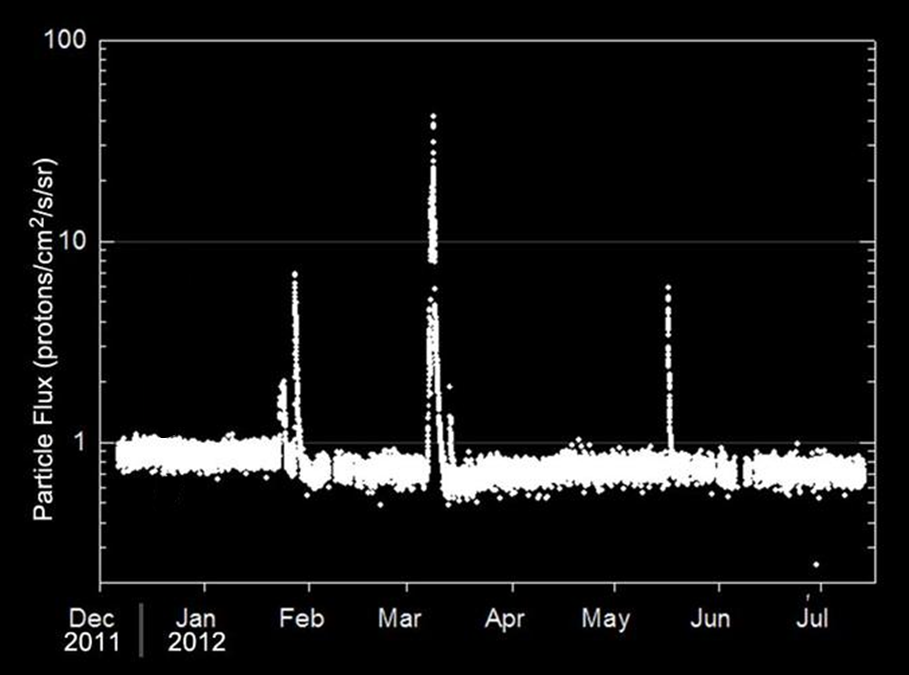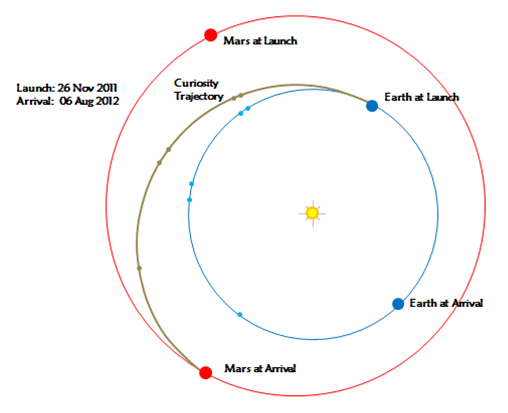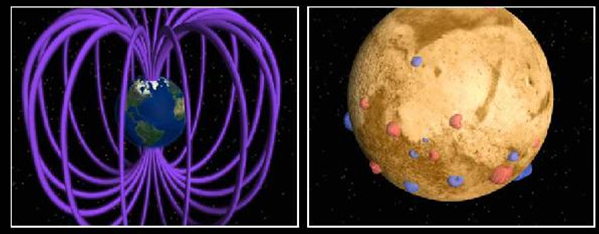On August 6th, the Curiosity spacecraft successfully touched down on the Red Planet after a journey lasting nearly 8.5 months. During its trip, the onboard RAD-instrument (Radiation Assessment Detector) measured systematically the number of energetic particles to get an idea of the radiation hazard to which future astronauts en route to Mars might be exposed. Indeed, when such a time comes, astronauts will have to leave the safe cocoon of the Earth's magnetosphere, being fully and for a long time exposed to the incessant bombardment of energetic particles from the Sun, galactic cosmic rays and other sources. So, it comes as no surprise that scientists want to understand a little bit better the circumstances in which the future astronauts will have to venture.

A few days prior to the landing, scientists from NASA/JPL released the graph above displaying the results from these radiation measurements taken during Curiosity's journey to Mars. It can readily be seen that the spacecraft was hit a couple of times by proton flares, i.e. clouds of fast moving energetic particles sometimes ejected during powerful eruptions on the Sun. Could the measured peaks in proton numbers be traced back to proton flares observed here on Earth? The peaks apparently correspond to solar events on 23 and 27 January, 7 and 13 March, and 17 May. The schematic underneath shows the position of Mars, Earth and Curiosity's trajectory, with all three moving in a counter-clockwise direction around the Sun. The small blue and brown dots indicate the position of the Earth and the Curiosity probe on the aforementioned dates. There seems to be a really good correspondence, except perhaps for the 17 May event.

This seems to be confirmed when studying additional details of these proton events (see the NOAA/SWPC-page at http://www.swpc.noaa.gov/ftpdir/indices/SPE.txt ). Seen from Earth, the 17 May event took place at the western solar limb, meaning that the flare was invisible from Curiosity's field of view! Yet, it is certainly not impossible that the three were still connected, even if the eruption took place far on the backside of the Sun (as seen from Curiosity). This was demonstrated as recently as 23 July: Sunspot region NOAA 1520 had already crossed the solar limb for 3 days when it produced a very strong flare of which a small proton signature was still observed here at Earth (see a previous STCE News Item)!

Above table summarizes the main characteristics of the flares: timing, sunspot region (NOAA numbering), flare strength (all Medium and eXtreme flares), and location (distance to central meridian of the Sun: East is to the "left", West is to the "right"). Also mentioned are the number of particles measured by the GOES-13 spacecraft (in orbit around Earth) for medium (red) and high (green) energy levels, as well as the numbers measured by the RAD-experiment (blue). The medium energy levels are very important, as they are usually used to determine if a flare is a proton event or not, and how strong it is. However, at first glance, these low-energy peak values do not correspond well to the ones measured by RAD. This is because also RAD can observe protons at different energy levels (http://mslrad.boulder.swri.edu/instrument.html ), and the ones displayed in the graph are from the higher energy levels. Then, comparing apples (RAD high energy protons) with apples (GOES-13 high energy protons), the peak values correspond much better. After May 17th, 6 other proton events were registered at Earth, but they were either much smaller than the previous ones, or the position of the source region did not favor a good magnetic connection with the Earth and Curiosity. Hence, no trace of these events can be seen in the RAD-data.

"The RAD website will eventually show near-real-time observations of the radiation environment on the surface of Mars, sort of a daily 'Space Weather at Mars' update," said Donald Hassler, principal investigator (PI) of the RAD-team. The first results are already available online (see also image underneath), showing that the radiation levels at Mars are currently about half of what was measured during Curiosity's cruising stage to Mars. Hence, Curiosity's measurements provide very valuable data for future (manned) Mars explorations.

 |
 |





